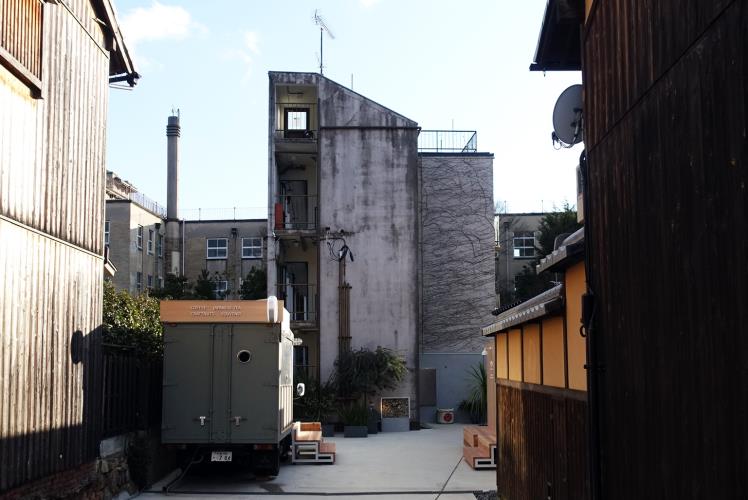Japan-based writer and traveller, specialising in design, lifestyle and travel journalism. Ron previously served as an editor of MING Magazine, ELLE Decoration and CREAM.

When passing through Kyoto, I noticed there were many construction vehicles digging on the ground with their machine arms. An old house used to stand on that ground. It’s uncertain to me what this place would look like in the future when the construction is completed. In Kyoto, the number of old houses being torn down has been increasing in the city, replaced by one-story modern houses that can be seen in almost every corner of Japan. It’s a great shame to see this, but it’s also understandable since the young people who inherit them find it even more expensive to maintain them than tearing them down and building new ones. Because of that, it’s even a greater joy for me to find old buildings that have survived and are reborn.
The truth is, Kyoto still boasts quite many buildings and compounds converted from old buildings, such as Kyoto Art Centre which used to be the Meirin Primary School, Kyoto International Manga Museum which used to be the Tatsuike Primary School, and hotels converted from traditional wooden townhouses (Machiya). Kyoto-based real estate company Hachise deals with the sales of Machiya, with a professional design department dedicated to converting Machiya into modern living spaces that cater to the young generation. It’s unfortunate that these buildings would lose their original charm because of the new design, but their exterior design is therefore preserved as a result. Compared with buildings like the Meirin Primary School and the Tatsuike Primary School that are considered as western mansions that showcase the fusion of western culture and Japanese culture, Machiya are pure traditional Japanese houses. Recently, I visited the RC Hotel in Kyoto, through which I am able to get a glimpse of the sides of Kyoto that visitors seldom see—a building of bizarre visions, sub-culture, and acceptance of different ways of living.
RC Hotel is located in the preserved historic site in the Kiyomizu-dera area, where it’s not allowed to build any buildings that are taller than two-story. The hotel was actually built before this regulation came into force. Being four-story high, RC hotel pops up among the old houses in this historic area. However, RC Hotel does not strike you as a modern and fancy hotel when you first see it from the outside, but rather looks old and crappy. It’s quite the vibe you get from Kyoto. RC Hotel is an old concrete compound, formerly used as an apartment building. Without proper maintenance over the years, all residents had gradually all moved out from the building. After taking over, RC hotel’s founder Minakuchi was impressed by the vibe of the building itself and the surrounding environment as they clash with each other and create an amazing visual. He saw it as an opportunity to showcase how old and new elements fuse in the city of Kyoto, as well as how the “uptight” tradition and the openness of the young can coexist. Eventually, Minakuchi decided to keep the original features of the building and redesign it under the theme “Contrast”. Minakuchi believed that the hotel would be a portal through which visitors can see the interesting sides of Kyoto.
The hotel’s lobby has a fancy interior design and well decorated. In contrast to that, the hotel hallways and corridors were kept in its original forms. The metal doors are tattered, the fences and handrails are rusty. As the guests enter the hotel room, they would feel a different sense of design. The living space of the room is clean and comfortable. In the sleeping area, the guests would find a custom-made bed with a minimalistic and western design. The bathroom, which has a beautiful tile wall, uses the traditional Machiya townhouse sliding door. The wall paint was completely removed, leaving the worn-out concrete wall exposed. Guests can also find old screw holes on the wall left behind by the previous residents. From these, the guests can read the history and stories of this building. The hotel’s logo is also a heritage of the apartment building. It’s actually a random graffiti scribbled on the old front door.
Each floor of RC Hotel has its own theme. For instance, the third floor’s theme is art. For that, the third floor is used as an art space where the hotel rooms serve as exhibition halls that exhibit artists’ works. When I was visiting, the room was exhibiting the oil paint artist Ly’s works. Starting from this year, RC Hotel will begin to host various arts and cultural events, seminars and workshops, etc. It seems RC Hotel will soon become Kyoto’s new cultural space.
Another thing that really made me fall in love with this hotel is the hospitality of the receptionists. The two receptionists that served me, one from Macao and one from Taiwan, were both a bit shy. They didn’t have the professional smiles and speaking style that people in this industry commonly share. From my perspective, it’s very humane, unlike the formality produced by the standardised business operation. It’s also very Kyoto to me. They actually made the entire hotel experience more comfortable and made me feel at ease.
Kyoto’s culture is diverse, and its diversity is also reflected by different buildings here. If one day, old buildings here are all replaced by modern designs that look pretty much the same for economic and urban development, then Kyoto might lose its original charm and might no longer be the city that we dream to visit.